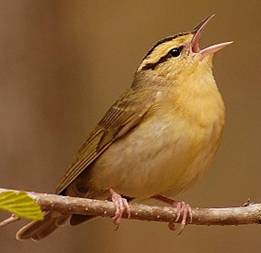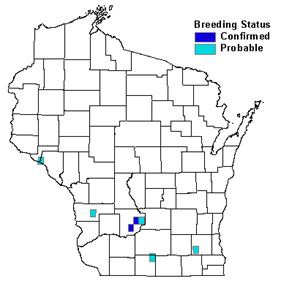Photo by Dennis Malueg


Status/Protection
- Global Rank: G5 Key to global and state ranks
- State Rank: S1B
- WBCI Priority: SGCN, State Endangered
Population Information
Federal BBS information can be obtained at http://www.mbr-pwrc.usgs.gov/bbs/bbs.html by clicking on Trend Estimates and selecting the species in question. All estimates are for 1966-2005.
- Federal Breeding Bird Survey: non-significant increase
- Federal Breeding Bird Survey (WI): N/A
- Federal Breeding Bird Survey (BCR 23): N/A
- Federal Breeding Bird Survey (BCR 12): N/A
- WSO Checklist Project: N/A (not numerous enough to be measured by the Checklist Project)
Life History
- Breeding Range: Missouri east across the Appalachian region into the New England states; local breeding populations in Wisconsin, Illinois, and areas west of the Mississippi River Valley (Hanners and Patton 1998).
- Breeding Habitat: Oak, Central Hardwood, mature deciduous forests with steep hillsides.
- Nest: Ground, well hidden along ravine or low in dense shrubs.
- Nesting Dates: Eggs: late May to late June (Hanners and Patton 1998).
- Foraging: Gleaning and probing; often hangs upside down while foraging on dead leaves (Ehrlich et al. 1988).
- Migrant Status: Neotropical migrant.
- Habitat use during Migration: Deciduous and mixed forests.
- Arrival Dates: Late April to early June (Robbins 1991).
- Departure Dates: Present until early September (Robbins 1991).
- Winter Range: Caribbean, Southern Mexico including the Yucatan Peninsula, and coastal Central America.
- Winter Habitat: Not well known but found in a variety of forest types, including evergreen, broadleaf, and plantations.
Habitat Selection
The Worm-eating Warbler inhabits large stands of deciduous and mixed deciduous-coniferous forest. It prefers steep wooded hillsides with dense patches of shrub cover (Hanners and Patton 1998), often on south-facing slopes (Mossman and Lange 1982). In Wisconsin, Mossman and Lange (1982) estimated that this species requires forests of at least 202 ha (500 acres) in Wisconsin. Despite being considered area-sensitive, Gale et al. (1997) noted that Worm-eating Warblers did not experience lower reproductive success in forest fragments located within a larger forested landscape in southwestern Connecticut. The Worm-eating Warbler nests on hillsides or banks of ravines, often near streams or wetlands. Nests are placed on the ground and are well-concealed under dead leaves against stumps, roots, shrubbery, or rocks (Hanners and Patton 1998).
The Worm-eating Warbler is reported in winter from low elevations (<500 m) along coastal Central America (Hanners and Patton 1998), and in a broad variety of forest types in Jamaica (Lack and Lack 1972). Habitat use during migration is poorly known, but likely similar to its nesting habitat (Hanners and Patton 1998).
Habitat Availability
Wisconsin is on the extreme northern edge of the Worm-eating Warbler’s breeding range (Hanners and Patton 1998). It is a rare spring migrant and rare summer resident in southern Wisconsin (Robbins 1991). Because of its dependence upon large forests stands (Robbins et al. 1989), suitable habitat for the Worm-eating Warbler in Wisconsin is limited. Forest fragmentation and development pressures have reduced the amount of suitable habitat available for this species within the state. Invasive plant species may be negatively impacting the remaining remnants of suitable habitat. Conservation and management strategies for this species should be focused in the Western Coulee and Ridges ecological landscape (WDNR 2005). Wyalusing State Park, the Baraboo Hills region, and Devil’s Lake State Park support suitable habitat for this species.
Population Concerns
Breeding Bird Survey data suggest a non-significant annual increase range-wide for this species (Sauer et al. 2005). Due to the rarity of the Worm-eating Warbler in Wisconsin, it is not sufficiently known whether the population is stable. This species is rarely recorded on either the Wisconsin routes of the Breeding Bird Survey or the Wisconsin Checklist Project (Temple et al. 1997, Sauer et al. 2005). Intensive, targeted survey efforts are necessary to obtain more precise population data. Very few nests were found during the six-year census period (1995-2001) of the Wisconsin Breeding Bird Atlas. Atlas observers confirmed breeding in just three locations in Sauk County, with possible breeding reported from Buffalo, Vernon, Green, and Waukesha counties (Cutright 2006).
The Worm-eating Warbler was likely never a common species in the state (Robbins 1991). Wisconsin is far from its core distribution and population; thus it will probably remain rare here. Threats to this species include forest loss and fragmentation on both the breeding and wintering grounds and Brown-headed Cowbird parasitism. Parasitism rates range from 0 to 75% in various states (Hanners and Patton 1998).
Recommended Management
Local populations of the Worm-eating Warbler will benefit from any measures to maintain large forest tracts in rough terrain and with dense undergrowth. Its distribution is patchy, even in the center of its range (Hanners and Patton 1998), so focused efforts in favorable microhabitats is recommended rather than large-scale plans.
Research Needs
Surveys and monitoring of suitable Worm-eating Warbler habitats are needed in southern and southwestern Wisconsin. Little is known of their nesting success, habitat requirements, and population status in the state. Habitat preferences and overwinter survival on the wintering grounds also should be investigated (Hanners and Patton).
Information Sources
- Birds of Forested Landscapes, Cornell Lab of Ornithology: http://www.birds.cornell.edu/bfl/speciesaccts/woewar.html
- North American Breeding Bird Survey: http://www.mbr-pwrc.usgs.gov/bbs/bbs.html
- Patuxent Bird Identification Center: http://www.mbr-pwrc.usgs.gov/id/framlst/i6390id.html
- Temple S.A., J.R. Cary, and R. Rolley. 1997. Wisconsin Birds: A Seasonal and Geographical Guide. Wisconsin Society of Ornithology and Wisconsin Department of Natural Resources, Madison, WI.
- Wisconsin Breeding Bird Atlas: http://www.uwgb.edu/birds/wbba/
References
- Cutright, N.J. 2006. Worm-eating Warbler. In Atlas of the Breeding Birds of Wisconsin. (N.J. Cutright, B.R. Harriman, and R.W. Howe, eds.) The Wisconsin Society for Ornithology, Inc. 602pp.
- Ehrlich, P.R., D.S. Dobkin, and D. Wheye. 1988. The birders handbook: a field guide to the natural history of North American birds. Simon & Schuster, Inc. New York.
- Gale, G.A., L.A. Hanners, and S.R. Patton. 1997. Reproductive success of Worm-eating Warblers in a forest landscape. Conserv. Biol. 11:246-250.
- Hanners, L.A., and S.R. Patton. 1998. Worm-eating Warbler. The Birds of North America, No. 367 (A. Poole and F. Gill, eds.). The Birds of North America, Inc., Philadelphia, PA.
- Lack, D., and P. Lack. 1972. Wintering warblers in Jamaica. The Living Bird 11: 129-153.
- Mossman, M.J., and K.I. Lange. 1982. Breeding birds of the Baraboo Hills, Wisconsin: Their history, distribution and ecology. Wis. Dep. Nat. Resour. and Wis. Soc. Ornithol., Madison.
- Robbins, C.S., D.K. Dawson, and B.A. Dowell. 1989. Habitat area requirements of breeding forest birds of the Middle Atlantic states. Wildl. Monogr. 103:1-34.
- Robbins, S.D., Jr. 1991. Wisconsin birdlife: Population and distribution past and present. Madison, WI: Univ. Wisconsin Press.
- Sauer, J.R., J.E. Hines, and J. Fallon. 2005. The North American Breeding Bird Survey, Results and Analysis 1966 - 2005. Version 6.2.2006. USGS Patuxent Wildlife Research Center, Laurel, MD.
- Temple S.A., J.R. Cary, and R. Rolley. 1997. Wisconsin Birds: A Seasonal and Geographical Guide. Wisconsin Society of Ornithology and Wisconsin Department of Natural Resources, Madison, WI.
- Wisconsin Department of Natural Resources (WDNR). 2005. Wisconsin’s Strategy for Wildlife Species of Greatest Conservation Need. Madison, WI.
Contact Information
- Compiler: Tom Klubertanz, tklubert@uwc.edu
- Editors: Kim Kreitinger, K.Kreitinger@gmail.com
